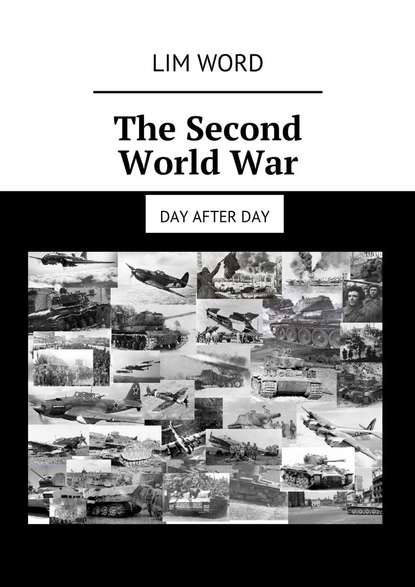По всем вопросам обращайтесь на: info@litportal.ru
(©) 2003-2024.
✖
The Second World War. Day after day
Настройки чтения
Размер шрифта
Высота строк
Поля
Invasion of France
The battle continues to unfold in neighboring Belgium, where the combined French, English, Belgian troops, and Wehrmacht forces converge on May 10—11. The first, truly grandiose operation of the Germans begins almost a failure: in the vicinity of Luxembourg, a motorized column of 41,000 units of equipment, a bumper to the bumper, stands in a 250-kilometer traffic jam. However, the confused allies and do not subject this light, desired goal to the bombing. Finally, 1,100 tanks break away from the concentration of infantry and break through the mountain serpentines to Belgium. Three days later, steel cars, with carriages filled with primitin, almost unimpededly cross the borders of France.
Of the battles of this period, one should note the first major tank battle at Ann, where 623 German (mainly Panzer 1—2) and 415 French (Renault, Gochkis, practically the same) tanks came together. The shortcomings of German armored vehicles were revealed – thin, 14.5 mm. armor and weak 20 mm. gun, against 45mm. armor and 37 mm. Guns tanks, Gochkis, whose crews, incidentally, consist of only two people. The tactics of the Panzerwaffe – beating with a single steel fist, with clear coordination over the radio and the clear purpose of the operation being conducted, shows superiority over the manner of the opponents to place the non-radiofected tanks in a shaky line. Belgium surrenders on May 28, its armed forces are getting out of the fight. Places of battle are moving to French Dunkirk. The movement of the German panzerwaffe is hampered by the rugged terrain; They also do not aspire to enter the zone of action of the large-caliber naval artillery of the British. Surrounded by Anglo-French troops, taking advantage of the bad weather, interferes with the actions of aviation, they are evacuated by the sea, leaving all their heavy equipment to the enemy. The idea to create here a springboard, a splinter in the body of fascist Continental Europe, is not considered.
Italy enters the war on the side of Germany; although its 300,000-strong army does not have much success, it completely demoralizes the French, and, on June 21, in the Compiegne Forest, where the Treaty of Versailles was signed 20 years ago, France’s surrender is announced.
The loss of Belgium: 6,000 people irrevocably, 202,000 prisoners, as well as 112 aircraft, France 84,000 killed, 1.8 million prisoners (the majority are sent to forced labor in Germany), 50 aircraft. Great Britain – 68,000 people, about 1,000 aircraft, 64,000 vehicles, Germany – 18,000 soldiers and officers on German data and 45,000 according to estimates of English historians, 432 aircraft. In addition to the developed French economy, Germany receives 2,000 combat tanks (used against guerrillas or converted into ACS), 1,400 aircraft and a 7,000-strong French volunteer legion. Part of the navy, in order to avoid its seizure by the Germans, together with 1,200 sailors, was destroyed by British aircraft (Operation Catapult), the remaining ships were sunk by the French themselves in 1942. The Catapult, coupled with the British preference for its soldiers during the evacuation from Dunkirk, led to the unwillingness of the French military in the French colonies (Syria, Senegal, Lebanon), to join the struggle against the Axis countries, and, in some cases, active resistance to the allies.
Meanwhile, the gold of the French National Bank, on the battleship Richelieu, on June 19, 1940, leaves the port of Brest and is heading for Senegal. He is adjoined by precious metals from Poland, Belgium and the Netherlands. Later, this charm falls into the hands of the Americans, and returns only seven years later, according to the Marshall plan, in the form of loans to, exclusively American goods.
1. Occupation of France by Germany and Italy
1. Occupation of France by Germany and Italy
Bessarabia and Northern Bukovina. On June 27, 1940, the government of the USSR sends an ultimatum to the Romanian government demanding the return of Bessarabia (rejected by Romania in 1920) and Northern Bukovina, as compensation for the exploitation of the population of Bessarabia. A few hours before the start of the Soviet invasion, the Romanian king accepts all his conditions. Territories are divided between Soviet Ukraine and Moldova. The population of Bessarabia, numbering 3.7 million people, indeed, which underwent many humiliations and terror from the Romanian authorities, as a whole is loyal to the Soviet government. Ethnic Romanians and Ukrainians (85%) Bukovina, 0.8 million people who did not feel this kind of attitude, regard annexation without enthusiasm.
Вы ознакомились с фрагментом книги.
Приобретайте полный текст книги у нашего партнера:
Приобретайте полный текст книги у нашего партнера:











